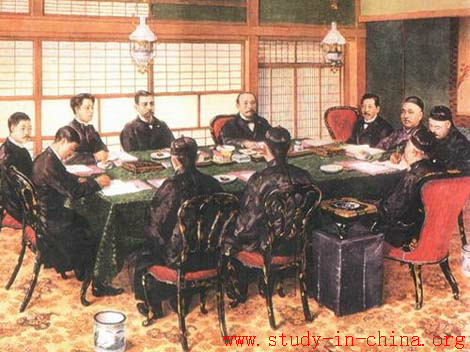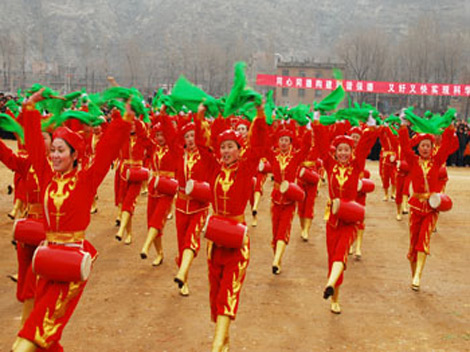| Home > China Feature |
Treaty of Shimonoseki (Treaty of Maguan)

The Treaty of Shimonoseki, known as the Treaty of Maguan (马关条约) in China, was signed at the Shunpanro hall on April 17, 1895 between the Empire of Japan and Qing Empire of China, ending the First Sino-Japanese War. The peace conference took place from March 20 to April 17, 1895.
Treaty terms
Article 1: China recognizes definitively the full and complete independence and autonomy of Korea, and, in consequence, the payment of tribute and the performance of ceremonies and formalities by Korea to China, that are in derogation of such independence and autonomy, shall wholly cease for the future.
Articles 2 & 3: China cedes to Japan in perpetuity and full sovereignty of the Penghu group, Taiwan and the eastern portion of the bay of Liaodong Peninsula together with all fortifications, arsenals and public property.
Article 4: China agrees to pay to Japan as a war indemnity the sum of 200,000,000 Kuping taels.
Article 6: China opens Shashih, Chungking, Soochow and Hangchow to Japan. Moreover, China is to grant Japan most-favored-nation treatment.
The treaty ended the First Sino-Japanese War of 1894–1895 as a clear victory for Japan. In this treaty, China recognized the independence of Korea and renounced any claims to that country. It also ceded the Liaodong peninsula (then known to the Western Press as Liaotung — the southern portion of Fengtian, now part of modern Liaoning province), the islands of Taiwan (Formosa) and Penghu to Japan. China also paid Japan a war indemnity of 200 million Kuping taels, payable over seven years, and the signing of a commercial treaty similar to ones previously signed by China with various western powers in the aftermath of the Opium Wars. This commercial treaty confirmed the opening of various ports and rivers to Japanese trade.
Value of the indemnity
In the treaty, China had to pay an indemnity of 200 million silver kuping taels to Japan.
One kuping (treasury) tael is about 37.3 grams in weight. The 200 million kuping taels is about 7.45 million kg of silver.
Later Japan was forced to re-cede the Liaodong peninsula, after the Triple intervention of Russia, Germany and France, Japan asked for more money — 30 million kuping (1.12 million kg) of silver — from China; the total amount is over 8 million kg of silver. Russia later took control of the peninsula and the geopolitically strategic Port Arthur.
Signatories and diplomats
The treaty was drafted with John W. Foster, former American Secretary of State, advising the Qing Dynasty. It was signed by Count Ito Hirobumi and Viscount Mutsu Munemitsu for the Emperor of Japan and Li Hongzhang and Li Jingfang on behalf of the Emperor of China. Before the treaty was signed, Li Hongzhang was attacked by a right-wing Japanese extremist on March 24: he was fired at and wounded on his way back to his lodgings at Injoji temple. The public outcry aroused by the assassination attempt caused the Japanese to temper their demands and agree to a temporary armistice. The conference was temporarily adjourned and resumed on April 10.
Art
 more
moreYicheng Hua Gu
The Flower Drum 花鼓 of southern Shanxi Province is a kind of folk d...

Sculpture in Qianling Mausoleum
The sculpture of Qianling Mausoleum is the main relic of the ground ...

A Sweet Art:Sugar Painting
In and around China’s southwestern Sichuan Province, it is usual to ...

Custom
 more
moreWeb Dictionary
Martial Arts
Bruce Lee
There’s a new biopic of martial arts expert Bruce Lee ahead of us....
Wudang Martial Arts
Wudang Wushu is one of the key schools of Chinese martial arts. ...
Wuxia, a Popular Culture for Most Chinese-Speaki...
Wuxia (武侠) is a broad genre of Chinese fiction that concerns its...





 print
print  email
email  Favorite
Favorite  Transtlate
Transtlate 







